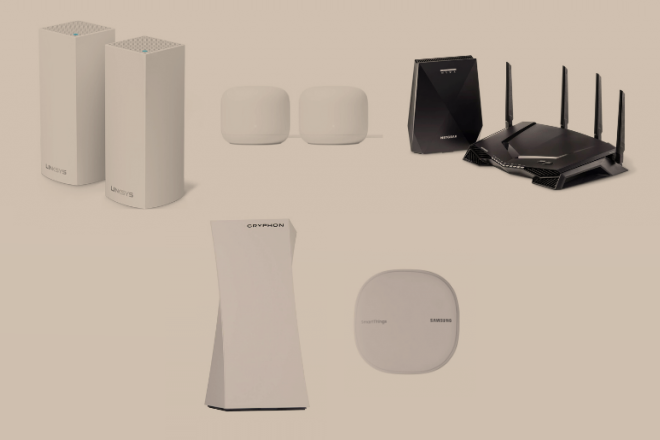Whole-Home Mesh Wifi systems consist of the main router that connects straight to the modem.
It also connects to satellite nodes or modules, located around your home or office for full wifi coverage. They’re all part of one wireless mesh network and share the same password and SSID.
This is not the case with traditional routers.
Imagine that you’ve just set up your network at home with the latest hardware and a 100 Mbps internet connection.
However, you can’t stream a video in your bathroom or bedroom. You called your ISP (internet service provider) and confirmed that everything is okay.
The chances are that your wifi isn’t set up properly for a mesh wifi system.
What Could be Slowing Down my Network?
Wifi dead spots or weakened signal could be the result of physical limitations.
Things like walls, doors, and floors of your home can come between you and your internet connection, especially if they’re made of concrete, brick or metal.
Also, it’s possible that the distance is just too big in a large home, and your regular router is only capable of reaching as far as the bedroom but not the garage, bathroom, or backyard.
It’s also possible that devices such as cordless phones, microwaves, or baby monitors are interrupting your wifi connection.
If you stay in a complex, this issue increases tenfold.
Covering Your Home with Wifi
The solution is wifi that suits your home design. Simply imagine a standard router like a speaker.
You could be playing music loudly in front of your house, however, your office in the back will only hear an echo. This is how traditional routers work.
This is where mesh wifi routers kick in. Why not setup a “speaker” in every single room that you want a wifi connection? This is how mash wifi routers work.
That is why they provide solid wifi coverage around the home.
Modular expansion
A modular mesh wifi system is scalable and flexible, giving customers a customizable way of expanding their wifi without having to add range extenders.
I wouldn’t recommend range extenders because they’re not easy to use and have performance issues. Mesh wifi system, on the other hand, is easy to set up.
It’s like installing lights to illuminate your home. You can put your modules anywhere you want around your home or office.
It’s up to you to decide which rooms in your home need wifi and when you should add more nodes to extend the connection even further.
Easy installation and control
Most mesh wifi systems require a mobile app for easy installation. The app will show you what you need to do to get the most out of your system.
It will help you find dead spots, so you can put nodes in those zones that otherwise wouldn’t be covered or had a weak signal.
The app will also give you access to some interesting features to help you control your wifi such as guest access, device prioritization, parental controls, and so on.
Sleek design that blends into your home interior
Today’s regular wifi routers are usually oversized and ugly.
They require extra space to increase the antennas and make a mess of cables that don’t look good. It’s hard to hide them behind the TV (trust me, I know).
And on top of that, hiding them reduces their wireless performance.
Most mesh wifi routers, on the other hand, have a sleek design. They come in different colors and blend into home interiors perfectly.
You can leave them just anywhere without worrying about wires. They almost look like decorations due to their elegant and compact design.
Highlighted features of mesh wifi system
Here are the main features to consider when buying a home wifi system:
Wireless and wired expansion
In a modular home wifi system, one node is connected to the modem and acts as the main router.
Each extra node seeks for the best path and channel to connect to the previous one wirelessly, building a reliable and seamless connection throughout the entire place.
However, if you already have Ethernet cables in every room, some mesh wifi home systems can connect the modules together with Ethernet cables to make a complete home wifi system.
Even using a wired alternative, you will still be able to increase your signal to dead spots such as garage, backyard or basement.
Seamless roaming and one network
“Mesh Network” means that every part of your system works together and seamless roaming is an ideal example of that.
When you use a range extender and router combination, you have to change between the networks as you move from one room to the other manually.
However, with seamless roaming, you have a single network with one password and name.
This means that as you move around your office or home, you will not have to change from one network to the other manually.
You will be able to stream videos in your bathroom, basement or garage without worrying about weak or dropped connection.
Guest work
Using a guest network will keep your main wifi network secure. It will block outside users from stealing your personal data.
However, it will still allow you to provide a wifi connection to your babysitter or guests without putting your information at risk.
Why Should I Avoid Range Extenders?
Range extenders aren’t the same as mesh wifi systems.
They are effective when it comes to boosting the range of your router. However, they do so at the cost of your wifi performance. It gets cut in half.
That is why I recommend mesh wifi system over range extenders.
In a large home where wifi tries to cover every corner, a range extender can worsen the situation. It will diminish the performance of your network.
You can also experience problems when jumping from your router to your extender because you need to change networks manually.
Final Verdict
Not all mesh wifi systems are made equal. However, some of them perform better than others. That is why I recommend doing your own research before buying.
That is also why I wrote this guide on how to choose the right mesh wifi system for you. Have you ever used mesh wifi systems? Which ones do you recommend?
What is your experience with mesh routers or range extenders? Share your thoughts and experiences in the comments below.




